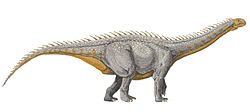| Arkharavia Temporal range: Late Cretaceous,
| |
|---|---|

| |
| Restoration as a somphospondylan | |
| Scientific classification | |
| Kingdom: | Animalia |
| Phylum: | Chordata |
| Class: | Reptilia |
| Clade: | Dinosauria |
| Clade: | Saurischia |
| Clade: | †Sauropodomorpha |
| Clade: | †Sauropoda |
| Clade: | †Macronaria |
| Clade: | †Titanosauriformes |
| Clade: | †Somphospondyli |
| Genus: | †Arkharavia Alifanov & Bolotsky, 2010 |
| Type species | |
| Arkharavia heterocoelica Alifanov & Bolotsky, 2010
| |
Arkharavia (meaning "Arkhara road") is a dubious genus of somphospondylan sauropod, although at least some of its remains probably belong to a hadrosaurid.[1] It was discovered in the Udurchukan Formation in Russia and lived during the Late Cretaceous. It was described in 2010 by Alifanov and Bolotsky as the type species A. heterocoelica.
Description
[edit]The holotype material consists of a single anterior caudal vertebra. Also, a tooth and a few proximal tail vertebrae (from near the base of the tail) were originally described as belonging to this species, but these probably belong to an indeterminate hadrosaur.[1][2] The vertebrae are unusual in being weakly heterocoelous,[3] which means that the centrum or body of a vertebra has saddle-shaped surfaces where it meets the vertebrae in front or behind it.
Classification
[edit]Arkharavia was originally classified as a titanosauriform sauropod, thought to be related to Chubutisaurus, a sauropod from the Cretaceous of Argentina.[3] However, further study showed that the referred vertebra in fact belonged to a hadrosaurid.[2] The holotype vertebra is currently considered an indeterminate somphospondylan.[1]
Contemporaries
[edit]Arkharavia lived in the Amur Region, which was a 'hot spot' for dinosaurs in Russia. Other dinosaurs from the area include the lambeosaurines (hollow-crested duckbills) Amurosaurus, Olorotitan, and Charonosaurus, and the saurolophine (duckbills without hollow crests) Kerberosaurus and Wulagasaurus.[3]
See also
[edit]References
[edit]- ^ a b c Mannion, Philip D.; Upchurch, Paul; Barnes, Rosie N.; Mateus, Octávio (2013). "Osteology of the Late Jurassic Portuguese sauropod dinosaur Lusotitan atalaiensis (Macronaria) and the evolutionary history of basal titanosauriforms" (PDF). Zoological Journal of the Linnean Society. 168: 98–206. doi:10.1111/zoj.12029.
- ^ a b Godefroit, P.; Bolotsky, Y.L. & Bolotsky, I.Y. (2011). "Osteology and relationships of Olorotitan arharensis, a hollowcrested hadrosaurid dinosaur from the latest Cretaceous of Far Eastern Russia". Acta Palaeontologica Polonica. 57 (3): 527. doi:10.4202/app.2011.0051.
- ^ a b c Alifanov, V. R.; Bolotsky, Y. L. (2010). "Arkharavia heterocoelica gen. et sp. nov., a new sauropod dinosaur from the Upper Cretaceous of the Far East of Russia". Paleontologicheskii Zhurnal (in Russian). 2010 (1): 76–83. Bibcode:2010PalJ...44...84A. doi:10.1134/S0031030110010119.











